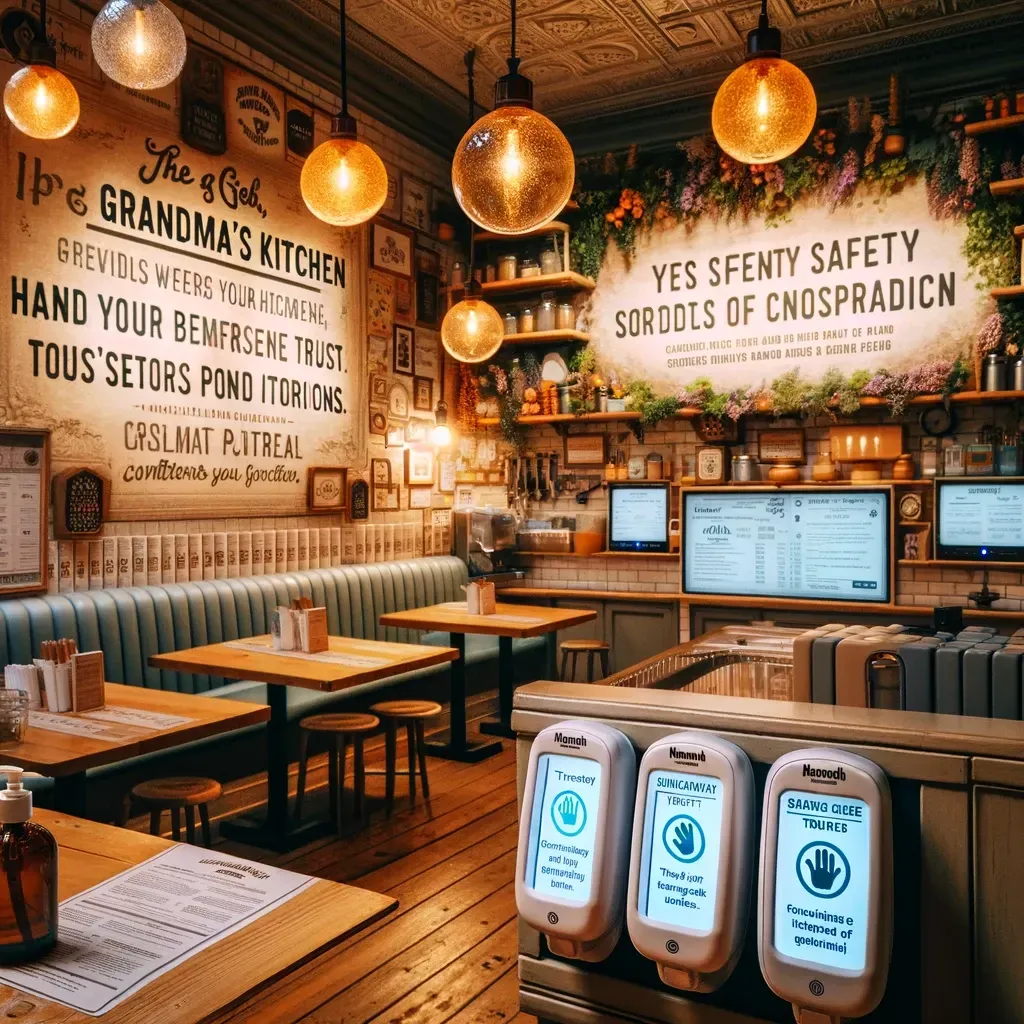Social Media
Client Social Media
Reviews

The Road and other Blogging Adventures

Grandma's Kitchen: A Recipe for Nurturing Safety and Trust in Your Business
Grandma's Kitchen: A Recipe for Nurturing Safety and Trust in Your Business
Introduction:
In the quaint corners of a bustling town, "Grandma's Kitchen" stood as a beacon of warmth and comfort, a place where generations of families congregated over shared meals and stories. However, when uncertainty and concern swept through the community, Hannah, the spirited owner, faced the challenge head-on. This tale isn't just about overcoming adversity; it's a masterclass in weaving safety, transparency, and trust into the very fabric of a business. As we embark on this journey, let's uncover the ingredients of Hannah's recipe for creating a sanctuary where customers not only dine but also find reassurance and connection.
Highlight Key Points:

Protocols
Transforming "Grandma's Kitchen" into a haven of safety without losing its essence, from hand sanitizers to digital menus.
Transparency
How Hannah's open communication turned potential anxiety into customer loyalty, setting a new standard for customer engagement.
Ethics
The role of ethical sourcing in building a community of trust, where every meal tells a story of commitment and care.
Responsiveness
Hannah's attentive approach to customer concerns, showcasing the power of personalized service in strengthening customer bonds.
"Grandma's Kitchen" became more than a restaurant; it evolved into a symbol of resilience and trustworthiness. By prioritizing customer well-being and embracing transparency, Hannah crafted an atmosphere where safety protocols felt like extensions of her hospitality.
In-Depth Analysis:
Building a Culture of Safety
Strategies for integrating safety measures that protect without alienating, turning necessary protocols into seamless aspects of the customer experience.
Fostering Open Dialogue
Techniques for maintaining an open line of communication with customers, from social media updates to in-person reassurances, ensuring transparency is both a practice and a promise.
Ethical Practices as Trust Pillars
Exploring the impact of ethical sourcing and sustainable practices on customer trust, demonstrating how a business's values can align with those of its patrons.
Personalized Responses to Concerns
The art of addressing customer worries with empathy and efficiency, reinforcing trust through every interaction.
Real-World Examples:
Beyond the inviting doors of "Grandma's Kitchen," this section will introduce businesses across various sectors that have successfully navigated the challenges of maintaining safety and trust, highlighting their innovative approaches and the outcomes of their efforts.
Practical Applications:
Implementing Safety Protocols
Step-by-step guide on creating a safe environment that respects customer concerns and regulatory guidelines.
Engaging in Transparent Communication
Tips for crafting messages that reassure and inform, ensuring customers feel valued and heard.
Adopting Ethical Business Practices
Advice on integrating ethical sourcing and sustainability into your business model, enhancing customer trust and loyalty.
Cultivating Responsive Customer Service
Strategies for developing a customer service ethos that prioritizes attentiveness and personalization, fostering lasting relationships.
Conclusion:
Through her unwavering dedication to safety, transparency, and ethical practices, Hannah transformed "Grandma's Kitchen" into a sanctuary where trust was always on the menu. Her journey underscores the critical importance of prioritizing customer well-being and trust in building a resilient and beloved business. Let this story inspire you to revisit your own business practices, ensuring that every decision you make reinforces the safety and trust of your customers.
Call to Action:
Is your business ready to follow in the footsteps of "Grandma's Kitchen"? Start by evaluating your current safety protocols and communication strategies. Share your story of adaptation and resilience or seek advice in the comments below. Together, let's create a community where safety and trust are the cornerstones of every business.
FAQs
Q: How can I implement robust safety protocols without compromising the customer experience?
A: Integrate safety measures seamlessly into the customer experience by using aesthetically pleasing sanitization stations, digital menus, and other contactless solutions that enhance convenience. Ensure all safety protocols are communicated clearly but warmly, making them feel like part of your hospitality rather than a barrier.
Q: What strategies can I use to communicate openly and honestly with customers about safety measures?
A: Utilize multiple communication channels including your website, social media, email newsletters, and in-store signage to explain your safety protocols. Be transparent about the reasons behind these measures and how they protect both customers and staff. Regular updates can help reassure customers that their well-being is always a priority.
Q: How do I ensure my business upholds ethical practices in all operations?
A: Conduct a thorough audit of your supply chain, employee policies, and business practices to identify areas for improvement. Commit to sourcing ethically produced goods, offer fair wages, and create a diverse and inclusive work environment. Publicly share your commitments and progress to build trust with customers.
Q: What are some effective ways to be responsive and attentive to customer concerns about safety?
A: Train your staff to listen actively and respond empathetically to customer concerns. Establish a dedicated channel for safety-related inquiries, such as an email address or a section on your website. Act swiftly to address any issues, and consider customer feedback when revising safety protocols.
Case Study: "Grandma's Kitchen: A Model of Safety and Satisfaction"
Background
In the wake of the pandemic, "Grandma's Kitchen," a beloved family restaurant, faced challenges in maintaining its cherished dining experience while ensuring customer safety.
Actions Taken
Hannah, the owner, introduced hand sanitizers at every table, digital menus accessible via QR codes, and plexiglass dividers, enhancing safety without losing the restaurant's warm atmosphere. She launched a transparent communication campaign detailing their safety efforts and introduced ethical sourcing by partnering with local farmers.
Outcome
The restaurant not only rebounded but also saw an increase in customer loyalty and new patronage, proving that safety and ethical practices, coupled with transparent communication and responsiveness to customer concerns, can lead to business success and customer satisfaction.
Emerging Trends in Customer Safety and Trust
Digital Transformation for Safety:
The integration of technology in creating safer business operations, such as the use of apps for contactless payments and orders.
Sustainability and Ethics
A growing consumer preference for businesses that prioritize sustainability and ethical practices, impacting purchasing decisions.
Personalization and Privacy
Balancing personalized customer experiences with heightened concerns over data privacy and security.
Community and Connection
Leveraging social platforms not just for marketing, but for building community, sharing safety updates, and fostering a sense of connection and trust with customers.
Resources
Centers for Disease Control and Prevention (CDC) (www.cdc.gov): Guidelines for businesses on maintaining safe operations.
Hootsuite (www.hootsuite.com): Social media management tools that can help businesses communicate effectively with customers.
Fair Trade Certified (www.fairtradecertified.org): Information and resources for businesses looking to adopt fair trade practices.
TrustArc (www.trustarc.com): Solutions for ensuring data privacy and building customer trust in digital experiences.
Zing Business Systems (website: zingacp.com/home) revolutionizes how businesses talk to customers by turning missed calls into texts, which helps close the communication gap. This technology saves potential sales and improves customer interaction across multiple channels. It streamlines customer management and tracks important data for marketing and sales. Enhance your customer service and boost your online marketing with Zing and don't lose customers from missed calls.
Start your own blog checklist:
Here is a quick checklist to get you started with you website blow. Remember imperfect action beats inaction, get started and keep publishing.
Create your blog page then add the blog element
Add the blog element to your page and select if you want compact or list view
Start planning your blog topics by Identifying what resonates with your audience. If you are stuck you can use sites like - https://answerthepublic.com/
Create an outline serves your company goals.
Write conversationally, like if you were telling a story to a friend
Pick a catchy title.
Use several media types (gif, short video, or image) to deliver your messages.
Use data to back up claims or ideas - make sure to cite all sources❗
Have a call to action and or give your audience something to walk away with.
Take 30 minutes to edit your post.
Copyright© 2024 The Missed-Call Text-Back . All Rights Reserved.








Facebook
Instagram
X
Youtube
TikTok